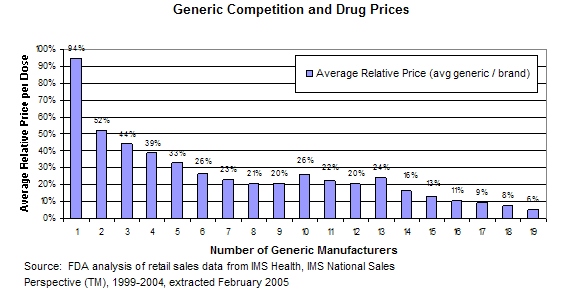 |
 |
 |
 |
 | |||||
| |||||||||
|
|
|
|
|
Generic Competition and Drug Prices Generic competition is associated with lower drug prices, with the entry of the second generic competitor being associated with the largest price reduction. We base this conclusion on an analysis of IMS retail sales data for single-ingredient brand name and generic drug products sold in the U.S. from 1999 through 2004.1 We define a product as having the same compound (active ingredient) and dosage form, ignoring differences in strength and package sizes. For every branded product in the database, we computed the price per dose (extended unit) each month. For the generics, we computed, for all manufacturers of a product, the average price per dose each month and the number of manufacturers. We then combined these two datasets, by product and month, and computed the ratios of the average generic price to the corresponding branded product's price. We ignored any products for which we did not have both branded and generic sales of at least 1000 doses in a given month2. Finally we grouped the ratios according to the number of generic manufacturers and computed the average of the individual price ratios. Figure 1 shows these results. Figure 1
On average, the first generic competitor prices its product only slightly lower than the brand-name manufacturer. However, the appearance of a second generic manufacturer reduces the average generic price to nearly half the brand name price. As additional generic manufacturers market the product, the prices continue to fall, but more slowly. For products that attract a large number of generic manufacturers, the average generic price falls to 20% of the branded price and lower. 1 IMS Health, IMS National Sales Perspective (TM), 1999-2004, extracted February 2005 2 The IMS data contains many instances of products with very low sales volume in a given month, but whose prices can be much different than those of higher volume products. Since this analysis averages individual price ratios without regard to sales volume, eliminating products with low sales volume eliminates the impact of these outliers on the averages. Date created: April 4, 2006 |
